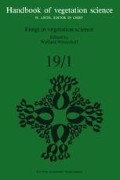Abstract
Readers will perhaps be surprised to find a volume about fungi within a handbook of vegetation science. Although fungi traditionally feature in textbooks on botany, at least since Whittaker (1969), they have mostly been categorised as an independent kingdom of organisms or in contrast to the animal and plant kingdom as probionta together with algae and protozoa. More relevant for ecology than the systematic separation of fungi from plants is the different life style of fungi which in contrast to most plants live as parasites, saprophytes or in symbiosis. Theoretical factors aside, there are also practical methodological considerations which favour the distinction between fungal and plant communities, as has been shown for example by Dörfelt (1974).
Access this chapter
Tax calculation will be finalised at checkout
Purchases are for personal use only
Preview
Unable to display preview. Download preview PDF.
References
Agerer, R. 1985. Zur Ôkologie der Mykorrhizapilze. Bibliotheca mycologica 97.
Apinis, A. E. 1972. Facts and problems. Mycopath. Myc. Appl. 48:93–109.
Arnolds, E. 1981. Ecology and coenology of macrofungi in grasslands and moist heathlands in Drenthe, the Netherlands. Bibliotheca Mycologica 83.
Arnolds, E. (red.) 1985. Veranderingen in de paddestoelenflora (mycoflora). Wetenschappelijke mededelingen K.N.N.V. 167:102 pp.
Arnolds, E. 1991. Decline of ecotomycorrhizal fungi in Europe. Agriculture, Ecosystems and Environment 35:209–244.
Barkman, J. J. 1976. Algemene inleiding tot de oekologie en sociologie van macrofungi. Coolia 19:57–66.
Barkman, J. J. 1987. Methods and results of mycocoenological research in the Netherlands. p. 7–38. In: G. Pacioni (ed.) Studies on fungal communities. University of Aquila, Italy.
Benkert, D. 1982. Vorläufige Liste der verschollenen und gefährdetem Groβpilzarten der DDR. Boletus 6:21–32.
Bujakiewicz, A. 1987. Indicative value of macromycetes in the forest associations of Mt. Babia (S. Poland). p. 41–47. In: G. Pacioni (ed.) Studies on fugnal communities. University of Aquila, ltaly.
Cooke, W. B. 1979. The ecology of fungi. CRC Press Inc., Boca Raton, Florida.
Cooke, R. C., and A. D. Rayner. 1984. Ecology of saprotrophic fungi. Longman, London.
Darimont, F. 1973. Recherches mycologiques dans les forets de Haute Belgique. Essai sur les fondements de la sociologie des champignons superieurs. Mém. Inst. Roy. sc. nat. Belg. 170.
Derbsch, H., and J. A. Schmitt. 1984. Atlas der Pilze des Saarlandes. 1. Verbreitung und Gerfährdung. Aus Natur und Landschaft im Saarland. Sonderband 2, Saarbrücken.
Dörfelt, H. 1974. Zur Frage der Beziehungen zwischen Mykocoenosen und Phytocoenosen. Arch. Natursch. Landschaftsforsch. 14:225–228.
Fellner, R. 1983. Mycorrhizae-forming fungi in climax forest communities at the timberline in Giant Mountains. Ceska mykol. 37:109.
Frankland, J., J. N. Hedger, and M. J. Swift (eds.). 1982. Decomposer basidomycetes. Their biology and ecology. Brit. Mycol. Soc. symposium ser. 4.
Haas, H. 1932. Die bondenbewohnenden Groβpilze in den Waldformationen einiger Gebiete von Württemberg. Beih. bot. Centralbl. B 50:35–134.
Harley, J. L. 1969. The biology of mycorrhiza (2nd ed.). Leonard Hill Books, London.
Harley, J. L., and S. E. Smith (eds.). 1983. Mycorrhizal symbiosis. Academic Press, London.
Höfler, K. 1937. Pilzsoziologie. Ber. dtsch. bot. Ges. 55:606–622.
Hueck, H. J. 1953. Myco-sociological methods of investigation. Vegetation 4:84–101.
Jahn, H. 1990. Pilze an Bäumen (2nd ed.). Patzer, Berlin, Hannover.
Jansen, A. E. 1989. De eerste bijeenkomst van het Europees Comite voor de bescherming van paddenstoelen. Coolia 32:11–13.
Kreisel, H. 1957. Die Pilzflora des Darβ und ihre Stellung in der Gesamvegetation. Feddes Rep. Beih. 137:110–183.
Meisel-Jahn, S., and W. Pirk. 1955. Über das soziologische Verhalten von Pilzen in FichtenForstgesellschaften. Mitt. Flor.-soz. Arbeitsgem. N.F. 5:59–63.
Nitare, J. 1988. Jordtungor, en svampgrupp pa tillbakagang i naturliga fodermarker. Svensk bot. tidskr. 82:341–368.
Rayner, A. D. M., and L. Boddy. 1988. Fungal decomposition of wood, its biology and ecology. John Wiley & Sons, Chichester.
Rypacek, V. 1966. Biologie holzzerstörender Pilze. VEB Gustav Fischer, Jena.
Whittaker, R. H. 1969. New concepts ofkingdoms of organisms. Science 163:150–161.
Winterhoff, W. 1975. Die Pilzvegetation der Dünenrasen bei Sandhausen (nördliche Oberrheinebene). Beitr. naturk. Forsch. SüdwestdeutschI. 34:445–462.
Winterhoff, W. et al. 1984. Voläufige Rote Liste der Groβpilze (Makromyzeten). p. 162–184. In: J. Blab, E. Nowak, W. Trautmann, and H. Sukopp Rote (eds.) Liste der gefährdeten Tiere und Pflanzen in der Bundesrepublik Deutschland. Naturschutz aktuell 1.
Wojewoda, W., and M. Lawrynowicz (1986). Red list of threatened macrofungi in Poland. p. 45–82. In: K. Zarycki, and W. Wojewoda (eds.) List of threatened plants in Poland. Polish Scientific Publishers, Warszawa.
Editor information
Editors and Affiliations
Rights and permissions
Copyright information
© 1992 Springer Science+Business Media Dordrecht
About this chapter
Cite this chapter
Winterhoff, W. (1992). Introduction. In: Winterhoff, W. (eds) Fungi in vegetation science. Handbook of vegetation science, vol 19. Springer, Dordrecht. https://doi.org/10.1007/978-94-011-2414-0_1
Download citation
DOI: https://doi.org/10.1007/978-94-011-2414-0_1
Publisher Name: Springer, Dordrecht
Print ISBN: 978-94-010-5065-4
Online ISBN: 978-94-011-2414-0
eBook Packages: Springer Book Archive

